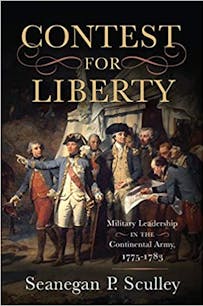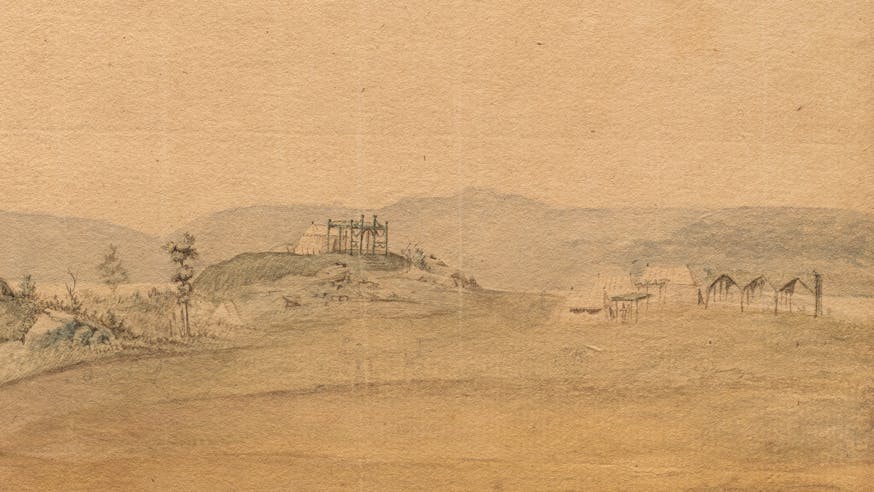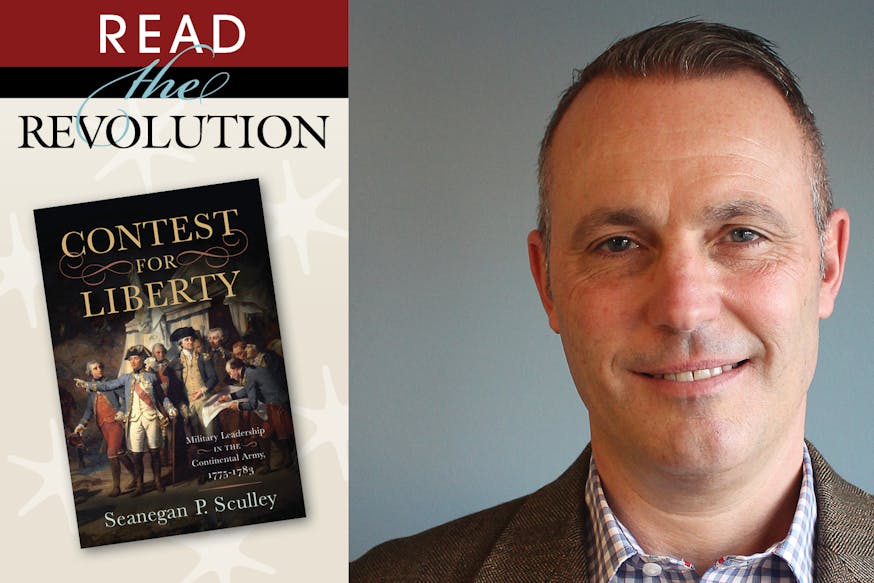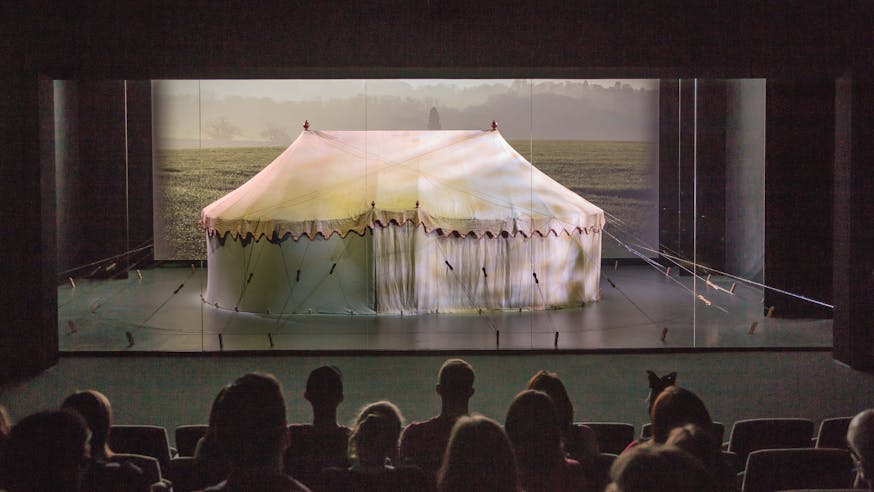Read the Revolution
Contest for Liberty
November 11, 2020
Purchase the book through Westholme Publishing.
The final years of the Revolutionary War, 1781-1783, are some of the most interesting in the history of the Continental Army. Among other challenges, General George Washington and other army leaders worked to model the ideals of the American Revolution while also maintaining the sagging morale of their soldiers. As we explored in our 2018 special exhibition, Among His Troops: Washington’s War Tent in a Newly Discovered Watercolor, they established impressive encampments, built ornamental structures, and invented new rewards for loyal troops, including the first U.S. military commendation: a purple heart awarded for loyal service.
In this excerpt from Contest for Liberty: Military Leadership in the Continental Army, 1775-1783, Lieutenant Colonel Seanegan P. Sculley, professor at United States Military Academy in West Point, New York, explores challenges that Washington faced in nearby Newburgh in 1782, when the war was far from over and soldiers grumbled in camp about broken promises and lack of pay. Common soldiers contemplated mutiny and officers even considered marching on Congress in protest. Washington, in a feat of republican leadership, quashed the simmering rebellion among his officers, an event that became known as the Newburgh Conspiracy, ending any speculation that he might use his military role to become a dictator. A few years later, this same bold but self-sacrificing leadership propelled him to elected office as the nation’s first president.
Excerpt
As the war drew to a close, Washington and the other officers of the army faced their final challenge to morale: a waning sense of purpose. Following the victory at Yorktown, the army was forced to remain encamped in the New York Highlands to maintain a careful watch over British forces still occupying New York City. For the officers and soldiers remaining in the army, this was a tense time, one of small skirmishes, foraging parties, no pay, little food, and an uncertain future. In order to maintain morale, Washington was forced to get creative.
His first order of business was to keep the soldiers spread across the Highlands busy. He organized a tour of his forces and he ordered them to perform a specific set of exercises, given to them by von Steuben. Washington would inspect every unit and critique them on their tactical abilities. Following the inspection, Washington issued general orders congratulating the officers and soldiers on their performance. All units looked professional (except a few regiments that had yet to receive hats) and all performed their exercises well (except a few that had difficulty conducting their training on such rugged terrain). Washington thanked von Steuben for all his hard work and encouraged regimental commanders to continue training and to change the routine of maneuvers but also to stay true to the established principles of the Blue Book.
Washington then created two new forms of recognition for his soldiers. The first was a thin white stripe of cloth, cut in an angular fashion, and worn on the left sleeve of the uniform coat. It would symbolize three years of brave and faithful service. Those soldiers who served for six years wore two stripes sewed parallel to one another. The second award was for any soldier or noncommissioned officer who served gallantly in a singular meritorious action. These men would be awarded a purple heart, cut from cloth, and sewed on the facings of his left breast. To be awarded such an honor, the soldier’s commander was required to certify the action with General Washington personally. The wearer of the Purple Heart would receive the privilege of passing the guards as officers did. These two distinctions are still in use in the modern US Army, though the Purple Heart now signifies that a soldier has been wounded in combat. His or her service stripes still represent three years of dedicated service each.
Washington had one final project to keep the men busy as they waited for the signing of the final peace treaty to end the war. On Christmas Day in 1782, Washington approved the suggestion of Reverend Dr. Israel Evans, the chaplain for the New Hampshire Brigade, who proposed the construction of a great public building for the common use of worship. For the next few months, officers and soldiers from across the army came together to collect the materials and expertise necessary. Colonel Tupper of the Massachusetts Line was placed in charge and the building was complete in early March 1783. It is perhaps ironic that the first meeting ever held there would later be called the Newburgh Conspiracy.
In the first week of March 1783 a letter circulated among the officers remaining in the army announcing a meeting to be held at the new public building to discuss the future of the officers and their soldiers. A few months earlier, in December, Major General Alexander McDougall, Colonel Matthias Ogden, and Colonel John Brooks traveled to Philadelphia as a committee representing the grievances of the army to Congress. Their desire to secure the pay owed everyone in the army and commute a promised pension to a lump sum payment for the officers was debated but not decided over the winter. Back at Newburgh, tensions were running high as all men in uniform contemplated the upcoming peace, the definite dissolution of the army, and the threat that they would all be forced to return home without a settlement of their accounts. Some officers decided more pressure was necessary to force Congress to honor its promises.
The letter sent to the officers, known as the Newburgh Address, was an emotional appeal, listing the wrongs done to the officers by Congress and declaring that only two options remained if Congress refused to resolve these issues regarding pay. If peace was declared, the officers could lead the army to Philadelphia and refuse to lay down their arms and disperse until their accounts were settled and commutation given. If the war did not end, the officers could lead the army west, leaving Congress vulnerable to British attacks. Washington immediately took control of the situation, issued a general order stopping the proposed meeting, and announced a meeting the next Saturday to discuss a report from McDougall’s committee. He assumed no officers would have attended the earlier meeting due to its “irregular” announcement but he requested that all officers attend his meeting with the senior officer in attendance to act as president. The president was to report the results of the meeting to Washington upon its conclusion.
The general order implied Washington would not attend the meeting personally. Major General Gates chaired the meeting as president, but before the discussions could begin, Washington walked into the building and began to attack the anonymous letter as emotional and dangerous. The two options presented in the letter were preposterous. If the army marched on Philadelphia, every objective of the Revolution would be compromised. If the officers marched the army west, they would not only leave Congress vulnerable, they would also place their families at risk. The only rational decision was to remain patient, trust that Congress would honor its responsibilities, and continue to lead the army to a victorious conclusion of the war. Following this appeal to his officers’ sense of commitment to the Revolution and their new country, Washington read the report from McDougall stating congressional support to address the army’s grievances. The officers unanimously agreed to support the Congress and a potential crisis was averted.
Seanegan P. Sculley, ‘Contest for Liberty’: Military Leadership in the Continental Army, 1775-1783 (Yardley, PA: Westholme Publishing, 2019) 152-154.
Read the Revolution is sponsored by The Haverford Trust Company.
Read the Revolution is published biweekly by the Museum of the American Revolution to inspire learning about the history of the American Revolution and its ongoing relevance.
Sign Up
Get biweekly Read the Revolution featured excerpts right to your inbox.
Tags
Learn More

Among His Troops: Washington's War Tent in a Newly Discovered Watercolor
January 13 - February 19, 2018
WATCH: Read the Revolution with Seanegan Sculley


